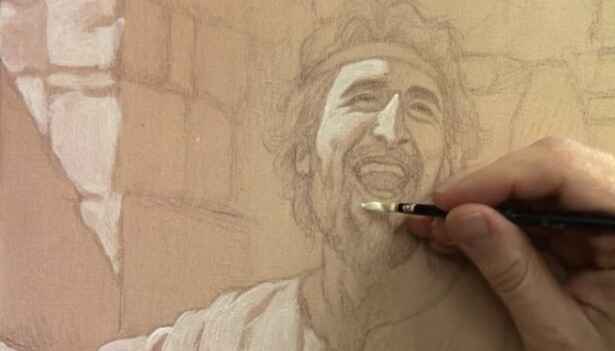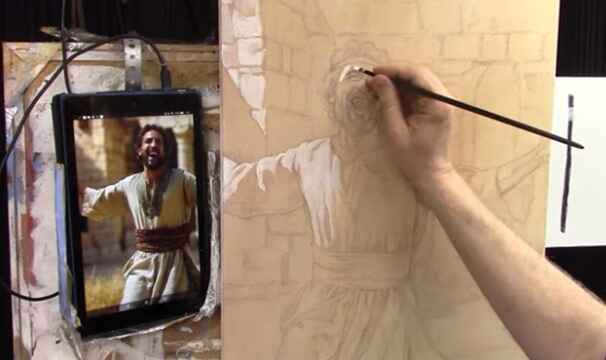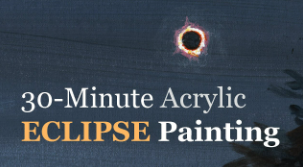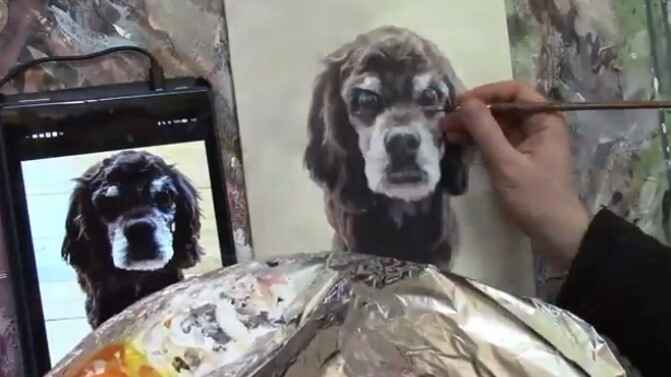Archive Monthly Archives: May 2024

How to Begin Acrylic Portrait Painting Grisaille—Titanium White
Learn the grisaille technique using titanium white for stunning acrylic portraits
Creating a compelling acrylic portrait often involves mastering various techniques. One such technique is grisaille, a method of painting in shades of gray, that helps to establish depth and dimension in your artwork. In this tutorial, we’ll explore how to start an acrylic portrait painting using titanium white, focusing on a depiction of King David rejoicing as the Ark of the Covenant returns to Jerusalem. This step-by-step guide will help you understand the process and give you practical tips to apply to your paintings.
Introduction to Grisaille Technique
Grisaille is a classic painting technique that involves creating a monochromatic underpainting. This technique was traditionally used to simulate sculpture and can serve as a strong foundation for adding color later. Using titanium white in the grisaille method helps in building up highlights and ensuring that the final painting has a vibrant and dynamic range of tones.

Setting Up Your Painting
- Sketching the Subject: Begin by sketching your subject. In this case, we’re focusing on King David with a joyful expression, arms outstretched, and dancing as the Ark of the Covenant returns to Jerusalem. Ensure your sketch captures the essential features and emotions of the subject.
- Applying the Ground Layer: Before starting the actual painting, apply a toning layer or ground. This is usually done with a mixture of colors such as raw umber or burnt sienna to create an earthy background that sets the stage for the painting.
Starting with Titanium White
Materials Needed:
- Titanium white acrylic paint
- Matte medium
- Small round brush
- Flat brush (optional)
- Spray bottle with water
- Palette
Step-by-Step Process:
- Mixing Titanium White: Mix titanium white with matte medium to create a slightly translucent paint. This mixture should have a consistency similar to warm honey, making it easy to apply and blend.
- Initial Application: Start applying the titanium white over the ground layer. Focus on the areas that will have the strongest highlights. For King David, this includes parts of his face, arms, and background elements such as the temple.
- Working from Left to Right: Since most people are right-handed, it’s beneficial to work from left to right to avoid smudging your work. Begin with the background, applying the titanium white to highlight the bricks and stones.
- Detailing the Subject: Move to the main subject, King David. Apply the titanium white to the illuminated areas of his face and body. Pay attention to the reference photo, ensuring you capture the highlights accurately.
- Blending and Precision: Use brush pressure to control the application. Light pressure will give you thinner, more precise lines, while heavier pressure will result in thicker, more opaque coverage. Blend the edges to create smooth transitions between light and shadow.
Tips and Techniques
- Glazing in Reverse: This technique involves painting light on dark instead of the traditional dark on light. It helps in building up the highlights gradually and achieving a smooth finish.
- Using Brush Pressure: Adjusting brush pressure is crucial for creating varying tonal values. Use less pressure for lighter applications and more pressure for thicker, more opaque strokes.
- Reloading the Brush: Reload your brush strategically to maintain a consistent application of paint. This ensures that the highlights remain strong and the transitions smooth.
- Avoid Reworking Dry Areas: Once an area has begun to dry, avoid going over it again. Reworking dry paint can lead to a blotchy and uneven finish.
- Reference Photo: Continuously refer to your reference photo. Painting what you see rather than what you think you see ensures accuracy in capturing the subject’s features and light effects.
Adding Finishing Touches
After establishing the highlights with titanium white, the next steps involve adding shadows and further refining the details. Once the grisaille underpainting is complete, you can start introducing color to bring the portrait to life. This method not only helps in achieving a realistic and three-dimensional look but also makes the subsequent layers of color more vibrant.
Using titanium white in the grisaille technique is an effective way to start an acrylic portrait painting. It allows you to focus on the tonal values and build a strong foundation for your artwork. By following the steps and tips outlined in this guide, you’ll be able to create a compelling underpainting that sets the stage for a vibrant and detailed final piece.
Read more about my additional resources, tutorials, to learn more and check my free courses. Whether you’re a beginner or an experienced artist, there’s always something new to learn and apply to your paintings. Happy painting!
LEARN MORE
- Sketching Your Painting Accurately
- Beginning a Pet Portrait in Acrylic
- The Mystery of Realism in Painting
- Apply A Burnt Sienna Glaze to a Portrait
- Learn How to Sketch a Portrait Freehand in 45 Minutes
- Adding highlights to your acrylic painting
- 5 Excellent Reasons to Use Aluminum Foil
- Paint Realistic Wrinkles in Acrylic
- Painting Clothing in an Acrylic Portrait
- Paint a Cloudy Sky Acrylic
- How to add Semi-Opaque Highlights
- How to Enhance the Contrast in Your Acrylic
- How to Add Glaze to Your Acrylic Painting
- Paint Realistic Reflections on Eyeglasses in an Acrylic Portrait
- Build Up Depth on Your Acrylic Portrait Backgrounds
- How Do You Do Layers With the Glazing Technique?
- Learn How to Paint Wrinkles in Acrylic
Read more about how to paint a portrait that you can surely be proud of!
I’d love to hear your thoughts on this video. Please share it with your friends and family. Let me know if you have any further questions. I’ll greatly help you.
If you’d like to learn more, sign up for my free email tips and video class today.
Learn How to Paint Acrylic Portraits With My Free Mini-Video Course!Thank you so much for taking the time to read this tutorial and watch the video. That means a lot to me. I hope you find it very helpful in your portrait painting.
Yours for Better Portraits,
P.S. Did you find this post helpful or encouraging? If so, send it in ahead! Let others know with the share buttons below. I’d love to hear your comments. Thank you so much! Also, do you have a question on acrylic portrait painting you’d like answered? Let me know, and I’d be happy to help!

How to paint Solar Eclipse: 30-Minute Acrylic Landscape Painting
Learn how to capture the solar eclipse in just 30 minutes using acrylic landscapes.
In this tutorial, we’ll guide you through creating a captivating 30-minute acrylic painting of a solar eclipse. Inspired by the recent Great American Eclipse, this lesson will teach you how to capture the dramatic lighting and unique atmosphere of the event in a fast-paced, yet comprehensive, painting session.
Materials Needed
- Acrylic Paints: Raw umber, burnt sienna, raw sienna, phthalo blue, ultramarine blue, alizarine crimson, napthol red, organic orange, Indian yellow, and titanium white.
- Brushes: Flat and round brushes (variety pack).
- Canvas: 8×10 canvas board.
- Additional Tools: Matte medium, water spray bottle.
Step-by-Step Painting Guide of 30-Minute Acrylic Landscape Painting
1. Setting the Scene
Start by setting up your canvas and palette. Begin by mixing a base color for the sky using raw umber, ultramarine blue, and titanium white. Aim for a periwinkle blue shade that will form the foundation of your sky. Apply this color across the top half of your canvas, blending it downward.
Tip: Use smooth, even strokes to cover the canvas, pushing hard to ensure the paint fills the weave of the canvas.
2. Creating Depth in the Sky
Once the base layer is applied, mix a lighter color using more titanium white and a touch of phthalo blue. Apply this lighter shade to the lower half of the sky to create a gradient effect. Add hints of indian yellow and organic orange to introduce a warm glow that reflects the twilight atmosphere of the eclipse.
Tip: Blend these colors gently where they meet to avoid harsh lines, and incorporate a few wispy clouds to enhance realism.
3. Painting the Horizon and Tree Line
For the horizon, mix a darker color with raw umber, ultramarine blue, and a bit of raw sienna. Use a flat-edged brush to block in the silhouette of the tree line. Keep the texture rough to suggest the trees and their branches without too much detail.
Tip: To create depth, use darker colors for thicker branches and lighter shades for thinner branches. This technique adds a sense of realism to your painting.
4. Adding the Solar Eclipse
As the painting progresses, focus on the solar eclipse. Mix titanium white with a small amount of napthol red and organic orange to create a base color for the eclipse. Use a small detail brush to paint the eclipse as a ring in the sky, placing it slightly off-center for a better compositional balance.
Tip: Add darker shades around the outer edge of the eclipse to emphasize its glow and create a sense of depth.
5. Enhancing Details and Final Touches
Once the eclipse is painted, add finer details such as solar prominences using a slightly lighter mixture of Titanium White and other colors. This step will bring a realistic fiery edge to the eclipse.
Tip: Use a dry brushing technique with matte medium to glaze over the painting, adding a final layer of depth and blending. Adjust the colors as needed to achieve the desired intensity and atmospheric effect.
6. Finishing Up
In the final minutes, make any necessary adjustments to the branches, add a bit more glow around the eclipse if needed, and ensure the overall balance of the painting is visually appealing.
Tip: Don’t rush the final touches; even with a 30-minute time constraint, small adjustments can make a significant difference in the overall appearance of your painting.
With this step-by-step guide, you should now have a vibrant and dramatic painting of a solar eclipse. Remember, practice makes perfect, so don’t be discouraged if your first attempt isn’t flawless. Enjoy the process and continue experimenting with different techniques to enhance your acrylic painting skills.
Read more about my additional resources, tutorials, to learn more and check my free courses. Whether you’re a beginner or an experienced artist, there’s always something new to learn and apply to your paintings. Happy painting!
LEARN MORE
- Sketching Your Painting Accurately
- Beginning a Pet Portrait in Acrylic
- The Mystery of Realism in Painting
- Apply A Burnt Sienna Glaze to a Portrait
- Learn How to Sketch a Portrait Freehand in 45 Minutes
- Adding highlights to your acrylic painting
- 5 Excellent Reasons to Use Aluminum Foil
- Paint Realistic Wrinkles in Acrylic
- Painting Clothing in an Acrylic Portrait
- Paint a Cloudy Sky Acrylic
- How to add Semi-Opaque Highlights
- How to Enhance the Contrast in Your Acrylic
- How to Add Glaze to Your Acrylic Painting
- Paint Realistic Reflections on Eyeglasses in an Acrylic Portrait
- Build Up Depth on Your Acrylic Portrait Backgrounds
- How Do You Do Layers With the Glazing Technique?
- Learn How to Paint Wrinkles in Acrylic
Read more about how to paint a portrait that you can surely be proud of!
I’d love to hear your thoughts on this video. Please share it with your friends and family. Let me know if you have any further questions. I’ll greatly help you.
If you’d like to learn more, sign up for my free email tips and video class today.
Learn How to Paint Acrylic Portraits With My Free Mini-Video Course!Thank you so much for taking the time to read this tutorial and watch the video. That means a lot to me. I hope you find it very helpful in your portrait painting.
Yours for Better Portraits,
P.S. Did you find this post helpful or encouraging? If so, send it in ahead! Let others know with the share buttons below. I’d love to hear your comments. Thank you so much! Also, do you have a question on acrylic portrait painting you’d like answered? Let me know, and I’d be happy to help!

How to Add Details and Finish Your Pet Portrait
Learn the detail and finishing touches your acrylic pet portraits
Creating a pet portrait that captures the essence of your beloved animal companion requires not only a good understanding of basic painting techniques but also a keen eye for details. In this tutorial, we will explore how to add intricate details and finish your pet portrait using acrylic paints. Whether you’re a beginner or an experienced artist, these tips and techniques will help you enhance the realism of your artwork.

The Glazing Technique
One of the key techniques used in creating a realistic pet portrait is glazing. Glazing involves mixing a small amount of paint with a large amount of matte medium. This creates a translucent layer that can be applied over existing paint to build depth and richness in color. Here’s how you can use the glazing technique in your pet portrait:
- Start with Darker Values: Begin by blocking in the darker areas of your portrait. This helps establish contrast, which is crucial for creating a realistic image. Use a mixture of ultramarine blue, raw umber, and dark alizarine crimson for rich, deep blacks instead of straight ivory black.
- Build Midtones and Highlights: After establishing the dark values, move on to the midtones. Use glazes to gradually build up the colors and textures. Add highlights using lighter colors, like titanium white mixed with your base colors.
- Layering for Depth: Apply multiple layers of glazes to create depth and dimension. Each layer should be thin and allow the underlying colors to show through. This technique is especially useful for rendering the soft, fluffy texture of fur.
Achieving Realistic Textures
Textures play a significant role in bringing your pet portrait to life. Here are some tips for achieving realistic textures:
- Fur Texture: Use a small round brush to add fine details to the fur. Vary your brush strokes to mimic the natural direction and flow of the fur. For areas with longer fur, use longer, sweeping strokes. For shorter fur, use shorter, more controlled strokes.
- Eyes: Eyes are often the focal point of a pet portrait. Treat them like parabolic mirrors that reflect the surrounding environment. Use colors like ultramarine blue and phthalo blue to create reflections and highlights in the eyes. Pay attention to the placement of light and shadow to make the eyes look lifelike.
- Nose and Muzzle: The nose and muzzle should have a soft, three-dimensional look. Use a combination of dark and light glazes to create the shape and texture. Pay special attention to the shadows and highlights around the nose and mouth.
Blending and Smoothing
Blending is essential for creating smooth transitions between different areas of your portrait. Here’s how you can achieve seamless blending:
- Use Matte Medium: Mix your paint with matte medium to create a smooth, translucent layer. This allows you to blend colors without losing their vibrancy.
- Work Quickly: Acrylic paint dries fast, so work quickly to blend colors while they’re still wet. This helps prevent harsh lines and create smooth transitions.
- Layering: Build up layers gradually, blending each layer into the previous one. This technique helps create a unified, cohesive look.
Finishing Touches
The finishing touches are what bring your portrait to completion. Here are some steps to ensure your pet portrait looks polished and professional:
- Add Final Details: Go over your painting and add any final details. This could include small highlights, additional fur texture, or refining the shadows.
- Check for Balance: Ensure that your painting has a balanced composition. Pay attention to the distribution of light and dark areas, as well as the overall harmony of colors.
- Ground Your Subject: Make sure your pet doesn’t look like it’s floating. Add shadows beneath the feet and around the body to ground your subject and create a sense of space.
- Sign and Varnish: Once you’re satisfied with your painting, sign it. Apply a final varnish to protect your artwork and enhance the colors.
Tips and Techniques
- Contrast is Key: High contrast between light and dark areas is essential for creating a realistic and engaging portrait.
- Use a Value Checker: A value checker tool can help you measure the lightness and darkness of your colors, ensuring accurate values.
- Keep Your Paint Wet: Acrylics dry quickly, so keep your paint wet by using a palette with a wet sponge or misting your palette with water.
- Work from General to Specific: Start with general shapes and values, then gradually add more specific details.
- Practice Patience: Building up layers and details takes time. Be patient and enjoy the process.
Creating a detailed and realistic pet portrait with acrylics requires practice and attention to detail. By using techniques like glazing, careful blending, and adding finishing touches, you can create a portrait that truly captures the spirit of your pet. Remember, the key to a successful painting is patience and persistence.
Read more about my additional resources, tutorials, to learn more and check out my free courses. Whether you’re a beginner or an experienced artist, there’s always something new to learn and apply to your paintings. Happy painting!
LEARN MORE
- Sketching Your Painting Accurately
- Beginning a Pet Portrait in Acrylic
- The Mystery of Realism in Painting
- Apply A Burnt Sienna Glaze to a Portrait
- Learn How to Sketch a Portrait Freehand in 45 Minutes
- Adding highlights to your acrylic painting
- 5 Excellent Reasons to Use Aluminum Foil
- Paint Realistic Wrinkles in Acrylic
- Painting Clothing in an Acrylic Portrait
- Paint a Cloudy Sky Acrylic
- How to add Semi-Opaque Highlights
- How to Enhance the Contrast in Your Acrylic
- How to Add Glaze to Your Acrylic Painting
- Paint Realistic Reflections on Eyeglasses in an Acrylic Portrait
- Build Up Depth on Your Acrylic Portrait Backgrounds
- How Do You Do Layers With the Glazing Technique?
- Learn How to Paint Wrinkles in Acrylic
Read more about how to paint a portrait that you can surely be proud of!
I’d love to hear your thoughts on this video. Please share it with your friends and family. Let me know if you have any further questions. I’ll greatly help you.
If you’d like to learn more, sign up for my free email tips and video class today.
Learn How to Paint Acrylic Portraits With My Free Mini-Video Course!Thank you so much for taking the time to read this tutorial and watch the video. That means a lot to me. I hope you find it very helpful in your portrait painting.
Yours for Better Portraits,
P.S. Did you find this post helpful or encouraging? If so, send it in ahead! Let others know with the share buttons below. I’d love to hear your comments. Thank you so much! Also, do you have a question on acrylic portrait painting you’d like answered? Let me know, and I’d be happy to help!
